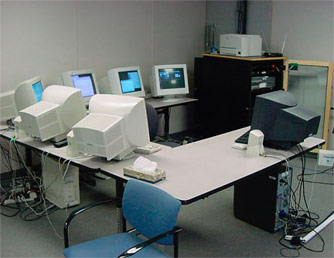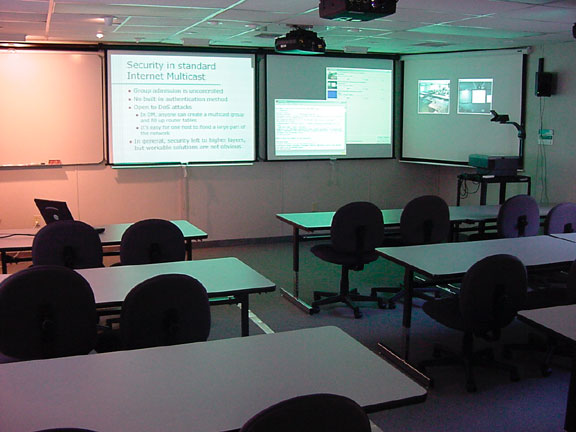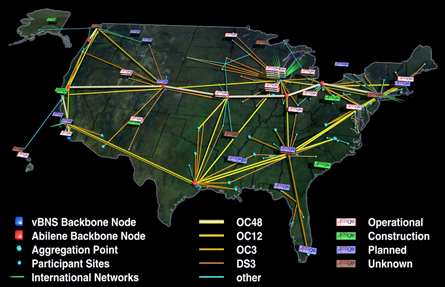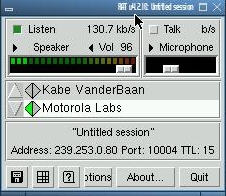| The Access Grid
(AG) is the ensemble of resources that can be used to support human
interaction across the grid. It consists of multimedia display,
presentation and interactive environments, interfaces to grid middleware,
and interfaces to visualization environments. The Access Grid will support
large-scale distributed meetings, collaborative work sessions, seminars,
lectures, tutorials and training. The Access Grid design point is
group-to-group communication (thus differentiating it from desktop to
desktop based tools that focus on individual communication). The Access
Grid environment must enable both formal and informal group interactions.
Large-format displays integrated with intelligent or active meeting rooms
are a central feature of the Access Grid nodes. Access Grid nodes are
"designed spaces" that explicitly contain the high-end audio and visual
technology needed to provide a high-quality compelling user experience. |
|
|
|
The Collaborative
Technologies Laboratory is a networked multi-media studio for real-time
interaction, video production, editing, archiving and distribution. The
room functions as a collaborative distance learning environment,
multi-party video conferencing facility for collaborative presentations,
research, and meetings, and a digital classroom for technology enhanced
learning. The flexibility of the infrastructure allows for a wide range of
potential uses for the room. Current and future research seeks to
determine what uses of the technology are pedagogically useful and which
are novel (at best), and to provide information to others who seek to
create or improve similiar collaborative research. |
|
|
The Collaborative Technologies Laboratory is an integrated research center. It is a multimedia hub, digital classroom, and collaborative research center which uses the World Wide Web as a core component of laboratory facilitates, distributed interaction and content distribution. |
|
|
The front wall of the classroom is set up for local presentions and for viewing of remote participants. Access Grid (see Access Grid) participants are projected on the right hand screen or screens with the local presenter projecting on the middle screen (if they are using Powerpoint or other computer media) or using the whiteboard. Speakers on either side of the room and mics throughout the room allow local and remote participants to engage in discussion. |
 |
tkMOO-light is an
advanced chat client suitable for use with muds and especially
MOO
systems. The client runs on UNIX, Windows and Macintosh platforms.
tkMOO-light is the ideal choice if you're looking for a single chat client which is able to run on different operating systems. |
 |
A powerful built-in text editor can be used for local editing of MOO verbs and properties and for composing MOO-mail messages. The client understands a range of local editing protocols including LambdaCore, MCP/1.0, MCP/2.1, MacMOOSE and Hash-hash (##). |
 |
The Access Grid is an integrated environment that supports group-to-group communication using high-speed networks over the Internet. It provides high-quality audio and real-time video that allow groups at multiple sites to interact simultaneously and share data and scientific instruments. |
 |
Meeting
participants (both local and distant) appear in windows projected onto a
large screen. The current display resolution at VisLab is 3840 x 1024
pixels. Additionally, data windows from participants' laptop computers can
be intergrated into the meeting (eg. display images, movies,
presentations, spreadsheets). |
|
|
http://internet2.motlabs.com/papers/handhelds_agnode_poster_final_normalpage.pdf HandHeld Devices with AG Nodes |
|
CVEs are typically enabled through fixed infrastructures and machines with significant computing power. Integrating wireless, handheld devices into such environments could add value to users because of their inherent flexibility. However, although handheld devices can provide value, they still generally lack the power interact independently with CVEs. |
|
|
|
The
Abilene
Project is named after a railhead established in Abilene, Kansas
during the 1860īs. In its time the ambitious railhead of the 1800's staked
a claim on what was then the frontier of the United States; the Abilene
Project establishes a foothold from which to explore and develop
pioneering network technology. The links of last century's railway changed
the way people worked and lived. The Abilene Project is transforming the
work of researchers and educators today. |
|
|
Robust Audio Tool (RAT) |




